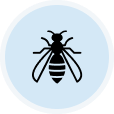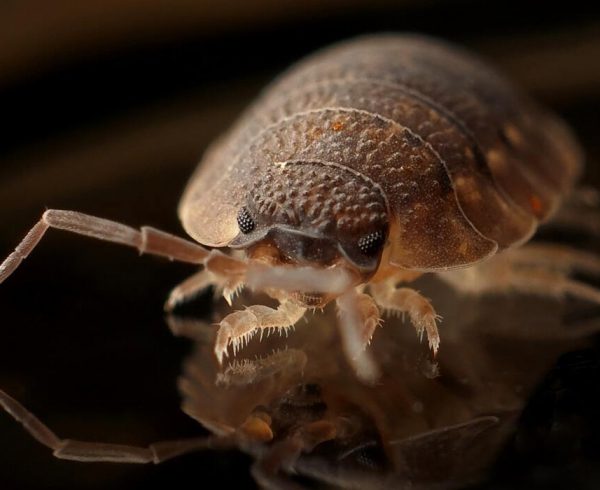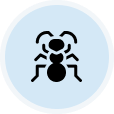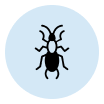After a long day of traveling, you finally pull into the driveway of your vacation rental and fling the door open, ready to crash for the night. But when you enter the bedroom to settle in, you notice something alarming: a musty, sweet smell and dark splotches all over the mattress.
You’ve just stumbled upon classic signs of a bed bug infestation. However, the last thing on your vacation checklist is dealing with rooms that have bed bugs. Moreover, you’ll probably want to avoid spreading the bugs to your home post-trip.
Fortunately, you can take steps to avoid catching bed bugs and manage them should you encounter them. It’s always best to let a pest control professional handle a full-blown infestation, but that doesn’t mean you can’t do anything to keep yourself and your family safe during your summer trip.
Key Takeaways
- Bed bugs are small pests that bite and feed off blood from animal hosts, including humans. They aren’t known for spreading disease but can still pose public health risks.
- Bed bug infestations are becoming more common as travel rates increase and awareness about bed bug prevention stagnates.
- You can minimize your risk of bed bugs by taking some preventative measures. Keep luggage away from spots where bed bugs tend to hide, and always inspect your lodging for bed bugs, eggs, and other telltale signs of an infestation.
- Report any areas of concern to your accommodation staff immediately.
 1st pest control service just $49
1st pest control service just $49
Must schedule service online.
Act now. Limited time offer.
What’s Up With Bed Bugs?
Bed bugs are common pests that have been around for generations. The Environmental Protection Agency (EPA), Centers for Disease Control (CDC), and the U.S. Department of Agriculture (USDA) all consider them a public health pest. Bed bugs are not known to transmit or spread disease, unlike other public health pests. Still, they can cause other public health issues.
Adult bed bugs are about the size of an apple seed and have long, brown, flat, oval-shaped bodies. They may appear more balloon-like if fed recently and adopt a reddish-brown hue. Bed bugs usually smell and produce a “musty-sweetish” odor.

Younger bed bugs and bed bug eggs may be invisible to the naked eye, especially because they tend to be pearl-white or yellowish-white in color.
Bed bugs hide during the day, often on beds, mattress seams, box springs, bed frames, headboards, and cracks or crevices. Like mosquitos, they come out at night to bite and feed on blood.
A combination of higher travel rates, increased resistance of bed bugs to pesticides, and a general lack of awareness about preventing infestations allows bed bugs to spread to hotel rooms, hostels, and vacation rentals worldwide.
Bed bugs are small. They also love to hide. As a result, it’s easy for bed bugs to infest luggage, clothing, and bedding, some of which may travel great distances and introduce the bed bugs to a new environment to thrive.
While bed bugs aren’t known for causing diseases, they can cause itchy, inflamed bites that may cause allergic reactions in some people. It’s also possible to develop secondary skin infections from a bite reaction.
Finally, bed bugs pose mental health risks for people living in infested spaces; a bed bug infestation can cause insomnia, anxiety, and systemic reactions that plague people even after bed bugs are gone.
Preparing for Your Trip
The time you spend preparing for your trip may be the best opportunity to take steps to avoid bed bugs. You can prevent these tiny hitchhikers from ruining your vacation plans or taking hostage in your home by following these tips.
Research and Choose Reputable Accommodations
Do your best to avoid choosing travel accommodations that might increase your risk of exposure to bed bugs. Look out for positive reviews and ratings as you search, and pay close attention to any reported bed bug incidents.
Pack Protective Items
Come to your vacation spot prepared to react if you spot signs of bed bugs. To help keep your property safe, you can encase your luggage with bed bug-proof covers. It also helps to keep your belongings stowed separately from those of others. You can store used clothing in plastic bags as an extra layer of protection.
Another wise idea is to bring a flashlight for thorough inspections of your hotel room or rental before unpacking and settling in. Pack essential bug repellents like EPA-registered pesticides that are proven to kill bed bugs. Ensure that any pesticides you use are intended for personal use to keep yourself and the environments you visit safe.
Non-chemical options include heat treatment (i.e., placing an infested item in a dryer on high heat) or cold treatment. However, access to these kinds of do-it-yourself bed bug elimination strategies can vary based on where you’re going.
They’re also not always effective. In a pinch, though, you can help reduce your risk of catching bed bugs by laundering your belongings with this in mind.
Inspect for Insects
Upon arrival, conduct a thorough inspection of your room. Look at the areas where bed bugs love to hide, including couches, luggage racks, mattresses, bed frames, etc. As you do, keep an eye out for signs of bed bug presence, including:
- Dark spots or stains on bedding or furniture, which may be remnants of bed bug droppings, dried blood, or crushed bed bugs
- Visible bugs or bed bug eggs
- Musty odor/distinctive smell
While some people react to bed bug bites, using them as a determining factor isn’t the best idea. Bed bug bites can closely mimic skin conditions or rashes, and some people don’t react to them at all.
Taking Preventative Measures
Preventing a bed bug infestation is far easier than treating one. It’s typically fairly straightforward to avoid bed bugs by entering each space you plan to stay at cautiously and with the following steps in mind.
- Keep your luggage away from the bed and furniture. Set all suitcases, backpacks, purses, and bags on a table or off the ground to keep them away from areas bed bugs love to hide.
- Utilize bed bug repellents to keep bugs at bay during your stay.
- Practice cleanliness and hygiene as much as possible. While bed bugs can live in any environment, regardless of how clean it is, it’s usually much easier for them to hide when more clutter is present. The more hiding spots you create, the more opportunity for breeding and growth you build.
- Launder clothes and luggage in hot water before heading home.
 1st pest control service just $49
1st pest control service just $49
Must schedule service online.
Act now. Limited time offer.
Dealing with Bed Bugs During Your Trip
If you spot one of these undesirable critters in your vacation rental, inform the hotel or accommodation staff immediately. Don’t attempt to handle the situation alone, and do your best to keep your belongings out of the area.
The hotel or accommodation staff should contact a professional pest control company to oversee a thorough bed bug extermination. In the meantime, request a room change or relocation to avoid bringing bed bugs home or along for the rest of your trip.
Any bed bug bites you notice will likely go away on their own, but don’t hesitate to contact a medical professional if you notice signs of an allergic reaction or rash.
By being a mindful traveler and equipped with proper knowledge about how to get rid of bed bugs, you can significantly reduce your risk of dealing with them during your summer trip.
This time of year is popular for travel worldwide, so it’s important to be extra cautious as you enjoy your vacations. Keep your belongings safe, look for signs of an infestation everywhere you stay, and don’t forget to have fun!







 You’re supporting a small, local business
You’re supporting a small, local business


